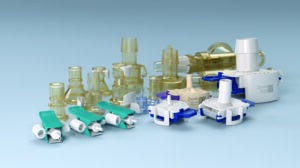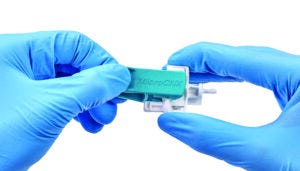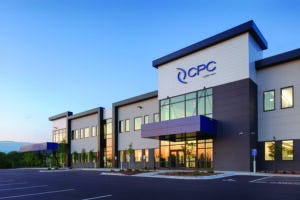- Sponsored Content
- Single Use
The Coevolution of the Single-Use and Biopharmaceutical Industries: Company and Industry Reflections from Colder Products Company (CPC)The Coevolution of the Single-Use and Biopharmaceutical Industries: Company and Industry Reflections from Colder Products Company (CPC)
August 22, 2022
Sponsored by Colder Products Company

CPC’s portfolio of single-use connection solutions for biopharmaceutical applications
Single-use technology (SUT), specifically its evolution from clinical applications to commercial production, has made a remarkable impact on bioprocessing. SUT flexibility and sterility have helped to build a strong foundation for manufacturers to initiate production of many different drugs quickly and cost-effectively, including vaccines and cell and gene therapies (CGTs).
Single-use systems make it economically feasible to manufacture therapies for diseases that affect relatively small patient populations — the kinds of numbers that might not justify an investment in a traditional stainless-steel operation. SUT users also can produce multiple drugs in one facility, addressing a much broader range of therapies than would have been possible before SUTs were implemented.
During the COVID-19 pandemic, SUTs have provided biomanufacturers with a level of flexibility that will prove to be just as valuable and necessary during less chaotic times. Many biopharmaceutical suppliers, drug developers, and contract development and manufacturing organizations (CDMOs) reallocated capacity typically earmarked for new therapies to commercial vaccine production. As COVID-19 vaccine production winds down and companies shift back to commercial production of therapies that were stymied by the pandemic, we can apply what we have learned to expedite development of both new drugs and products that were put on hold because of COVID-19.
We’ve experienced many revolutionary developments in single-use systems over the past 20 years, and the industry isn’t done making dramatic leaps. For instance, single-use systems are helping companies to take the leap into continuous processing and process intensification. SUTs provide just the flexibility, efficiency, and cost reductions that are needed for continuous bioprocessing to succeed.
The Evolution of CPC’s Solutions for Biopharmaceutical Manufacturing
In 1995, CPC introduced its first connector designed for medical markets. The MPC product became the industry standard for open connections in bioprocessing. Listening to the requirements and difficulties of early bioprocessing customers helped us to identify their need to make sterile connections between single-use bags and stainless-steel bioreactors. That discovery led to the introduction of our Steam-Thru line of connectors in 2002, which won the BioProcess International award for Manufacturing Technology of the Decade in 2012.
The success of Steam-Thru connectors opened up conversations with customers about other sterile-connection needs. Such discussions prompted the development of what has become CPC’s flagship product portfolio, the AseptiQuik series of single-use connectors. AseptiQuik connectors live up to their name: They make reliable, aseptic connections quickly and easily.
The goal of simplifying sterile connections advanced further with the introduction of genderless connection products. Genderless connectors, specifically those from our AseptiQuik line, enable users to join SUTs from different suppliers in a sterile process. Such flexibility has empowered customers to create their own innovations.
Customer observations and industry needs have inspired us to create a broad range of solutions that are designed to work from the smallest bioprocessing scales up to large-batch commercial processing — and everything in between. We also are addressing long-standing industry needs for solutions that can speed up bioprocess operations while decreasing dependence on operator technique. We recently introduced a new line of products that are designed to reduce or eliminate industry reliance on traditional tube-welding techniques to make sterile connections. That process involves multiple, labor-intensive steps and requires capital equipment and specially trained operators.

CPC MicroCNX single-use connectors for small-flow and low-flow bioprocess applications
Our latest two product offerings are good examples of our commitment to supporting streamlined operations. MicroCNX connectors enable operators to make sterile connections at small volumes, typically <10 L. Until recently, tube welding has been the only way to make sterile closed connections for narrow tubing. MicroCNX products are important because small-volume processing is becoming more common worldwide for early stage drug development and production of personalized medicines. Our new AseptiQuik G DC connector represents the first time that a genderless, sterile single-use connector can be used to make an aseptic connection and a disconnection using one product — and it doesn’t require ancillary equipment to do so. Both technologies could prove to be important contributors to bioprocess efficiency.
Developing “Backbone” Technologies
Even before COVID-19, biomanufacturers invested considerably in single use. The pandemic reinforced that SUTs are “backbone” technologies that help exciting new therapies reach the market rapidly. CPC has been evolving and innovating alongside SUTs and the biopharmaceutical industry for the past 20 years. As a result, CPC’s biopharmaceutical-focused business and the solutions that we create to support SUTs have grown significantly.
CPC’s capabilities for biopharmaceutical solutions run deep. We’ve built dedicated biopharmaceutical engineering and commercial teams (including teams for CGTs), production facilities, redundant manufacturing operations, logistics support, and more.
The way that we work has changed, too. We’ve moved from being primarily a product supplier to becoming a highly collaborative, trusted partner with end-user customers, original equipment manufacturers, and single-use component manufacturers. Customers seek out our fluid-management and connection-technology expertise when they’re designing their systems. We offer strong engineer-to-engineer collaboration to ensure that the right solutions are specified early on for our customers’ applications. We’re also part of industry organizations such as the Bio-Process Systems Alliance (BPSA) and BioPhorum Operations Group (BPOG) and participate in discussions about both marketed- and new-product technology needs.
COVID-19 required us to learn quickly how to collaborate effectively when interacting virtually. From voice-of-customer research to operator training to application development, we found new ways of getting the job done in a virtual environment. We also were among the first biopharmaceutical component suppliers to participate in the Rx-360 initiative to simplify and streamline critical auditing processes.

CPC’s headquarters in Roseville, MN
Accelerating Market Entrance of Life-Changing Therapies
In BPSA’s early days, we often noted that “all boats rise in a rising tide.” When the organization formed in 2005, I’m not sure that any of us knew how quickly and how high the tide of single-use was going to rise — and it does not seem to be slowing. But I have no doubt that the SUT market wouldn’t be growing as it is today were it not for the many accomplishments and contributions that all of us have made to this industry. We’re still in the early days of many promising therapies within the biopharmaceutical industry, and CPC is applying its deep experience in SUT connection solutions to those new applications. The current and potential impacts of personalized medicine are profound.
Although those of us on the supplier side of the biopharmaceutical industry might not possess the means to cure cancer, multiple sclerosis, or Crohn’s disease, the collective knowledge that suppliers continue to build across SUT platforms is accelerating the market entrance of new, life-changing therapies. For me, it doesn’t get much more rewarding than that.
John Boehm is vice president of the biopharmaceutical division of CPC, 2820 Cleveland Avenue North, Roseville, MN 55113; https://www.cpcworldwide.com/cgt; 1-651-645-0091.
You May Also Like






